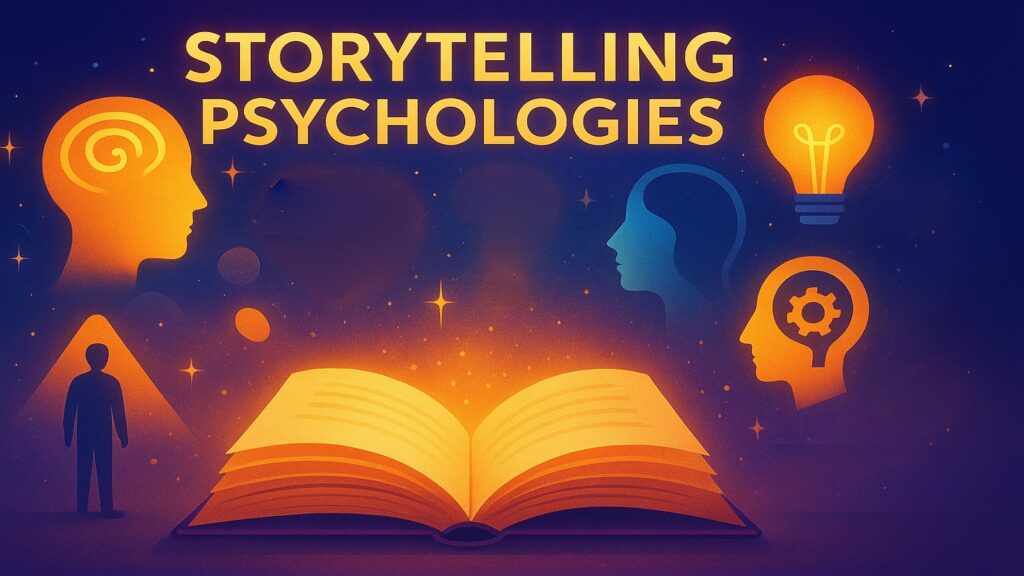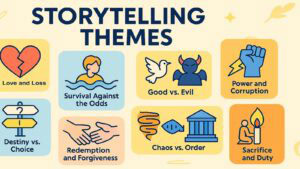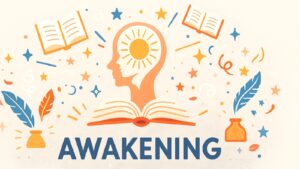Table of Contents
Introduction: Storytelling Psychologies as the Core of Creative Edge

Stories have shaped human consciousness since our ancestors gathered around fires, weaving tales that bound communities together. Today, neuroscience reveals what those ancient storytellers intuited: narratives literally rewire our brains. When we encounter compelling stories, our neural networks mirror the experiences of characters, creating profound psychological connections that transcend mere entertainment.
Storytelling psychologies represent the sophisticated understanding of how human minds process, internalize, and respond to narrative structures. These psychological principles function as invisible architects, constructing emotional landscapes that guide readers through carefully orchestrated journeys. Writers who master these psychologies don’t simply tell stories; they engineer experiences that resonate in readers’ minds long after the final page.
The eight storytelling psychologies explored here form a comprehensive toolkit for creative excellence. From the fundamental allure of the hero’s quest to the nuanced influence of subtext, every psychological element fulfills a specific role in the storyteller’s toolkit. Understanding these mechanisms transforms writing from intuitive guesswork into precise craft, allowing authors to predict and shape reader responses with remarkable accuracy.
These psychologies operate on multiple levels simultaneously. They influence immediate engagement, sustaining attention through carefully constructed tension and release patterns. They also create deeper connections, tapping into universal human experiences and archetypal patterns that speak to our collective unconscious. Finally, they establish lasting impact, ensuring stories survive in memory through strategic emotional anchoring and meaningful resolution.
Table 1: Core Components of Storytelling Psychologies
| Psychology Component | Primary Function | Reader Impact | Application Method |
|---|---|---|---|
| Emotional Triggers | Activate immediate response | Creates instant engagement | Strategic placement of high-impact scenes |
| Cognitive Patterns | Guide mental processing | Facilitates comprehension | Clear narrative style, structure and pacing |
| Memory Anchors | Ensure retention | Builds lasting impression | Memorable moments and symbolic elements |
| Psychological Hooks | Maintain attention | Sustains reading momentum | Unresolved tensions and compelling questions |
| Character Mirrors | Enable identification | Deepens emotional connection | Relatable flaws and universal struggles |
1. Storytelling Psychologies and Narrative Hook through the Hero’s Journey
The hero’s journey represents humanity’s most enduring narrative pattern, embedded so deeply in our collective psyche that it feels inevitable rather than constructed. Joseph Campbell’s monomyth reveals how this archetypal structure taps into fundamental psychological needs for growth, challenge, and transformation. When storytellers harness this pattern, they access a powerful technique – Narrative Hook – that immediately signals readers they’re embarking on a meaningful adventure.
Narrative Hook functions based on the concept of implied promise. As soon as readers identify markers of a heroic journey, their minds begin to expect the entire narrative arc: the departure from the ordinary world, the challenges faced, and the eventual transformation. This expectation fosters a psychological investment even before the story truly commences. The initial scenes do not simply present characters; they forge agreements with readers, assuring them of journeys that merit their time and emotional engagement.
Successful implementation of the hero’s journey and narrative hook requires understanding its stages as psychological waypoints rather than plot requirements. The call to adventure triggers curiosity psychology, while the refusal of the call activates empathy through relatability. The crossing of thresholds engages risk psychology, making readers vicariously experience the thrill of venturing into unknown territories.
Modern variations of the hero’s journey demonstrate its psychological flexibility. Stories can begin mid-journey, immediately thrusting readers into transformed worlds where heroes have already changed. Others invert the pattern, showing returns to ordinary worlds that no longer fit transformed characters. These variations work because they manipulate the same underlying psychological expectations while surprising readers with unexpected angles.
Table 2: Hero’s Journey and Narrative Hook: Psychological Triggers
| Journey Stage | Psychological Narrative Hook | Reader Response | Narrative Function |
|---|---|---|---|
| Ordinary World | Identification psychology | “This feels familiar” | Establishes baseline for change |
| Call to Adventure | Curiosity activation | “What happens next?” | Creates forward momentum |
| Refusal of Call | Relatability enhancement | “I understand that fear” | Builds character empathy |
| Meeting the Mentor | Guidance psychology | “Someone will help” | Provides comfort and direction |
| Crossing Threshold | Risk engagement | “This is exciting/scary” | Raises emotional stakes |
2. Storytelling Psychologies in Emotional Arc Engineering

Emotional arc engineering transforms stories from simple sequences of events into carefully orchestrated psychological experiences. Like composers arranging musical movements, skilled storytellers design emotional rhythms that carry readers through calculated highs and lows. This engineering process recognizes that human attention spans require variation; sustained intensity leads to numbness while constant calm breeds disengagement.
The psychology behind emotional arcs draws from research on hedonic adaptation, the tendency for humans to return to baseline emotional states despite significant positive or negative events. Storytellers counteract this adaptation by creating contrast patterns that prevent emotional flatlining. Strategic placement of quiet moments makes subsequent dramatic peaks feel more intense, while periods of tension make eventual relief more satisfying.
Effective emotional arc engineering involves mapping reader psychology across narrative time. Opening segments typically require gentle emotional escalation to avoid overwhelming audiences unfamiliar with story worlds and characters. Middle sections can sustain higher intensity levels as readers become invested, while conclusions demand careful balance between resolution satisfaction and emotional authenticity.
Professional storytellers recognize that different genres require distinct emotional arc patterns. Horror stories use fear escalation followed by brief relief periods, creating roller coaster psychology that keeps readers simultaneously terrified and unable to stop reading. Romance narratives employ emotional see-saws, alternating hope and uncertainty to maximize the satisfaction of ultimate romantic resolution.
Table 3: Emotional Arc Engineering Patterns in Storytelling Psychologies
| Arc Pattern | Emotional Sequence | Genre Application | Psychological Effect |
|---|---|---|---|
| Steady Climb | Low to high intensity | Adventure, thriller | Builds sustained excitement |
| Wave Pattern | Alternating highs/lows | Romance, family drama | Creates emotional rhythm |
| Roller Coaster | Extreme peaks and valleys | Horror, suspense | Maximizes adrenaline response |
| Inverted Arc | High to low to recovery | Tragedy, redemption | Generates cathartic release |
| Multiple Peaks | Several climactic moments | Epic narratives | Sustains long-form engagement |
3. Storytelling Psychologies and the Mirror Effect via Structuralism
Structuralism reveals how stories function as cultural mirrors, reflecting shared human patterns and archetypal relationships that transcend individual experiences. Claude Lévi-Strauss demonstrated that narrative structures contain universal elements that speak to collective unconscious patterns. When storytellers consciously employ these structural mirrors, they create characters and situations that feel simultaneously fresh and familiar.
The mirror effect operates through recognition psychology. Readers encounter story elements that remind them of fundamental human experiences: parent-child dynamics, rivalry between siblings, the struggle between order and chaos. These recognitions occur below conscious awareness, creating emotional responses that readers experience as intuitive connection with stories. Characters become compelling not through uniqueness alone, but through their embodiment of universal patterns.
Structural psychology in storytelling extends beyond character archetypes to encompass relationship dynamics and conflict patterns. The mentor-student relationship activates deep psychological needs for guidance and growth. Romantic triangles tap into competition psychology and scarcity concerns. These patterns work across cultures because they reflect fundamental aspects of human social organization.
Contemporary storytellers adapt structuralist principles for modern audiences by maintaining archetypal cores while updating surface details. A modern Odysseus might be a immigrant navigating bureaucratic systems rather than a warrior crossing mythical seas, but the underlying pattern of journey, obstacles, and eventual homecoming remains psychologically potent.
Table 4: Structural Mirror Elements and Storytelling Psychologies
| Archetypal Pattern | Universal Element | Psychological Recognition | Modern Adaptation |
|---|---|---|---|
| Hero/Shadow | Light vs. dark aspects | Internal conflict awareness | Protagonist facing personal flaws |
| Mother/Child | Nurturing/dependence | Attachment system activation | Protective relationships |
| Wise Elder/Student | Knowledge transfer | Learning psychology | Mentorship dynamics |
| Lover/Beloved | Romantic connection | Pair bonding instincts | Partnership formation |
| Trickster/Order | Chaos/disruption | Change adaptation needs | Rule-breaking characters |
4. Storytelling Psychologies in Suspense Psychology
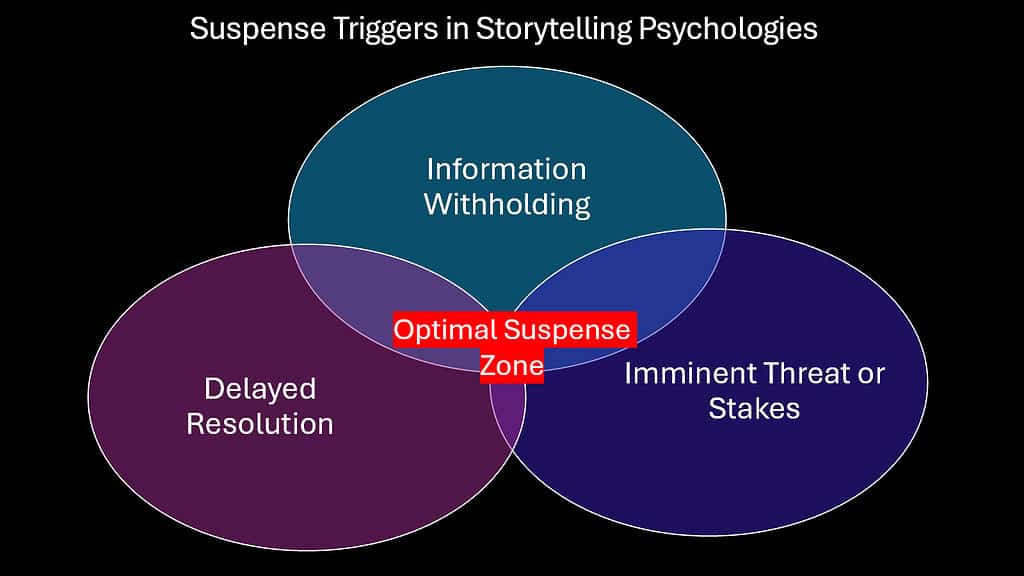
Suspense psychology leverages fundamental aspects of human cognition to create irresistible narrative tension. The mechanism operates through information asymmetry and the Zeigarnik effect, the psychological tendency to remember uncompleted tasks more vividly than completed ones. When storytellers strategically withhold information while hinting at its significance, they create cognitive loops that demand resolution.
Effective suspense psychology requires understanding the difference between mystery and confusion. Mystery engages active problem-solving psychology, inviting readers to participate in puzzle-solving alongside characters. Confusion, by contrast, frustrates pattern-recognition systems and causes disengagement. The key lies in providing enough information to make speculation possible while withholding enough to prevent premature resolution.
Time manipulation serves as a crucial tool in suspense psychology. Compressed timeframes create urgency psychology, while extended anticipation builds psychological pressure. Skillful storytellers vary these temporal rhythms to maintain optimal tension levels. They might stretch moments of high stakes into slow-motion psychological time while compressing routine activities to maintain narrative momentum.
The release of suspense requires psychological finesse. Premature resolution deflates tension, while delayed resolution risks reader frustration. Master storytellers often employ partial revelations that answer some questions while opening new ones, maintaining the cognitive engagement that drives page-turning behavior.
Table 5: Suspense Psychology Mechanisms
| Suspense Technique | Cognitive Mechanism | Reader Psychology | Implementation Method |
|---|---|---|---|
| Information Withholding | Curiosity gap creation | “I need to know” | Strategic revelation timing |
| False Clues | Pattern disruption | Recalibration response | Misdirection placement |
| Time Pressure | Urgency activation | Heightened attention | Deadline establishment |
| Multiple Threads | Cognitive juggling | Active engagement | Parallel plot lines |
| Partial Revelation | Dopamine regulation | Satisfaction/anticipation | Staged information release |
5. Storytelling Psychologies and Worldbuilding through Reader-Response Theory
Reader-response theory revolutionized literary understanding by recognizing that meaning emerges from the interaction between text and reader rather than residing solely within written words. Wolfgang Iser’s concept of “implied reader” and Stanley Fish’s “interpretive communities” reveal how stories become psychological spaces that readers actively inhabit and co-create through their engagement.
The psychology of worldbuilding functions based on the concept of mental transportation. When readers encounter vivid sensory details and emotionally resonant situations, their brains simulate these experiences as if they were personally occurring. This simulation process, documented through neuroimaging studies, shows that reading about experiences activates the same neural regions involved in actually having those experiences.
Effective worldbuilding and world immersion require balancing specific details with imaginative space. Too much description overwhelms readers and restricts their mental participation. Too few leaves worlds feeling empty and unconvincing. Skilled storytellers provide strategic anchor points—distinctive sensory details, emotional textures, cultural markers—that allow readers to construct complete environments in their minds.
The psychology of worldbuilding and world immersion also depends on internal consistency and logical coherence. Readers invest psychological energy in understanding story world rules, and violations of established patterns break immersion by forcing conscious attention to narrative mechanics. When worlds feel internally logical, readers can surrender conscious monitoring and fully enter transported states.
Table 6: Reader-Response Elements
| Worldbuilding Factors | Psychological Process | Reader Experience | Narrative Technique |
|---|---|---|---|
| Sensory Anchoring | Mental simulation | “I can feel this place” | Selective detail emphasis |
| Emotional Resonance | Empathetic engagement | “This matters to me” | Character vulnerability |
| Cultural Logic | Pattern recognition | “This world makes sense” | Consistent rule systems |
| Interpretive Space | Active participation | “I understand meanings” | Implicit storytelling |
| Temporal Flow | Narrative transportation | “Time disappears” | Engaging scene construction |
6. Storytelling Psychologies in Plot Twists
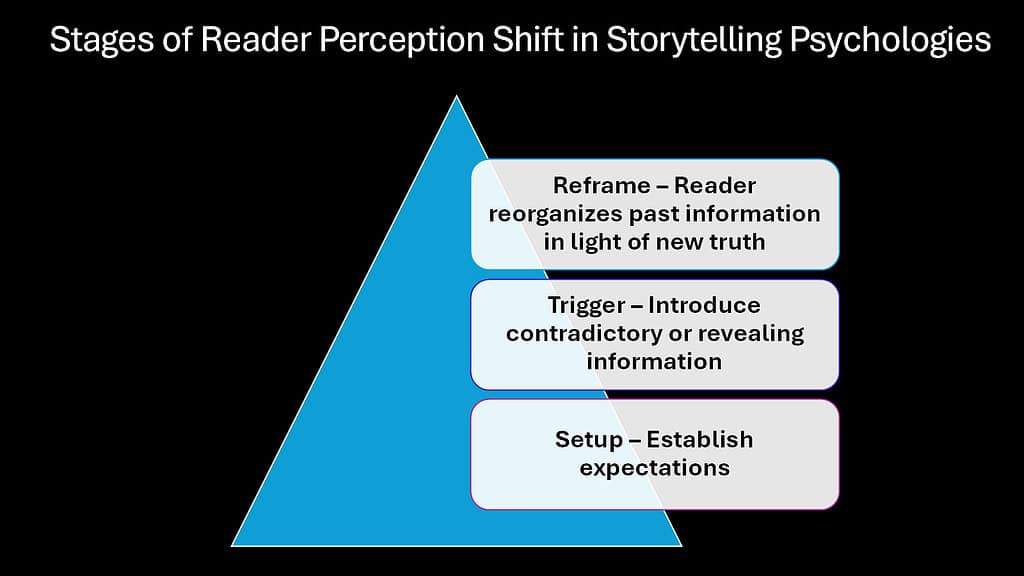
Psychology of plot twists exploits fundamental aspects of human pattern recognition and expectation formation to create memorable narrative surprises. The mechanism of Plot Twists works by establishing cognitive frameworks that readers use to interpret story events, then revealing information that forces the complete recontextualization of previously understood elements.
Effective psychology of plot twists requires a sophisticated understanding of reader expectation management. Writers must plant sufficient clues to make revelations feel inevitable in retrospect while disguising their significance during initial encounters. This balance demands careful attention to cognitive bias exploitation—using readers’ natural tendency toward confirmation bias to guide them toward incorrect but plausible conclusions.
The process of plot twists triggers powerful psychological responses because it mimics real-world learning experiences where new information fundamentally alters understanding of past events. This recognition creates satisfaction through the “aha moment” while simultaneously generating respect for the storyteller’s craft. Readers experience pleasure both from solving puzzles and from appreciating elegant misdirection.
Psychological research on insight formation reveals why effective plot twists feel satisfying rather than arbitrary. The human brain experiences dopamine releases when previously disconnected information suddenly forms coherent patterns. Stories that create these “connecting the dots” moments tap into reward systems that make narratives feel psychologically meaningful.
Table 7: Psychology of Plot Twists Mechanisms
| Elements of Plot Twists | Cognitive Process | Reader Response | Execution Strategy |
|---|---|---|---|
| Misdirection | Attention diversion | “I didn’t see that coming” | False emphasis placement |
| Clue Planting | Pattern building | “The signs were there” | Retrospective coherence |
| Expectation Setup | Framework creation | “This makes sense now” | Logical progression |
| Revelation Timing | Cognitive surprise | “Everything changes” | Strategic placement |
| Recontextualization | Mental restructuring | “I need to rethink everything” | Perspective shift |
7. Storytelling Psychologies in Subtext Psychology
Subtext psychology recognizes that human communication operates on multiple levels simultaneously, with implicit meanings often carrying more emotional weight than explicit statements. Stories that masterfully employ subtext create rich interpretive experiences that engage readers in active meaning-making, transforming passive consumption into collaborative creation.
The psychology behind subtext appreciation draws from theory of mind research, which examines how humans understand that others have beliefs, desires, and intentions different from their own. Readers naturally search for hidden meanings because real-world social interaction requires constant interpretation of unstated motivations and feelings. Stories that reward this interpretive instinct feel psychologically authentic.
Effective subtext psychology requires understanding the balance between implication and clarity. When subtext remains too buried, readers miss intended meanings and experience frustration. When implicit meanings become too obvious, the collaborative interpretive process breaks down and readers feel manipulated rather than engaged. Masterful subtlety allows readers to feel clever for detecting implied meanings.
Cultural context significantly influences subtext psychology. Shared cultural knowledge creates interpretive frameworks that allow certain implications to resonate while others fall flat. Contemporary storytellers must navigate between universal human subtexts that cross cultural boundaries and specific cultural subtexts that deepen meaning for particular audiences.
Table 8: Subtext Psychology Applications
| Subtext Type | Psychological Engagement | Reader Satisfaction | Implementation Method |
|---|---|---|---|
| Emotional Undercurrent | Feeling detection | “I sense what’s really happening” | Behavioral contradiction |
| Social Commentary | Pattern recognition | “This reflects larger truths” | Symbolic representation |
| Character Motivation | Mind reading | “I understand why they act this way” | Action vs. stated intention |
| Thematic Resonance | Meaning construction | “This connects to bigger ideas” | Metaphorical layering |
| Relationship Dynamics | Social psychology | “I recognize these patterns” | Unspoken tension |
8. Storytelling Psychologies and Moral Framing through Postmodernism
Postmodern approaches to moral framing recognize that ethical understanding emerges through multiple perspectives rather than absolute truths. Jean-François Lyotard’s critique of grand narratives and Jacques Derrida’s deconstruction theory inform storytelling psychologies that embrace ambiguity while still providing meaningful moral engagement.
Moral framing psychology operates through the recognition that readers bring their own ethical frameworks to story interpretation. Rather than imposing a single moral point of view, sophisticated narratives create spaces for ethical complexity where multiple valid perspectives can coexist. This approach respects reader intelligence while encouraging deeper moral contemplation.
The psychology behind postmodern moral framing draws from research on moral reasoning development. Adults typically operate using multiple moral frameworks simultaneously—consequences, duties, virtues, care ethics—and stories that acknowledge this complexity feel more psychologically authentic than those presenting simplistic moral binaries.
Contemporary storytelling often employs unreliable narrators and fragmented perspectives to create moral ambiguity that mirrors real-world ethical complexity. Readers must actively construct moral understanding from incomplete and potentially contradictory information, mimicking the interpretive work required in actual moral decision-making.
Table 9: Postmodern Moral Framing Elements
| Moral Element | Postmodern Approach | Reader Psychology | Narrative Technique |
|---|---|---|---|
| Truth Claims | Multiple perspectives | “Reality is complex” | Conflicting viewpoints |
| Character Judgment | Moral ambiguity | “People are complicated” | Flawed protagonists |
| Ethical Resolution | Open interpretation | “I must decide for myself” | Ambiguous endings |
| Cultural Values | Relativistic presentation | “Context matters” | Cultural comparison |
| Narrative Authority | Questioned reliability | “Can I trust this story?” | Unreliable narration |
Conclusion: Weaving Storytelling Psychologies into Timeless Creative Craft
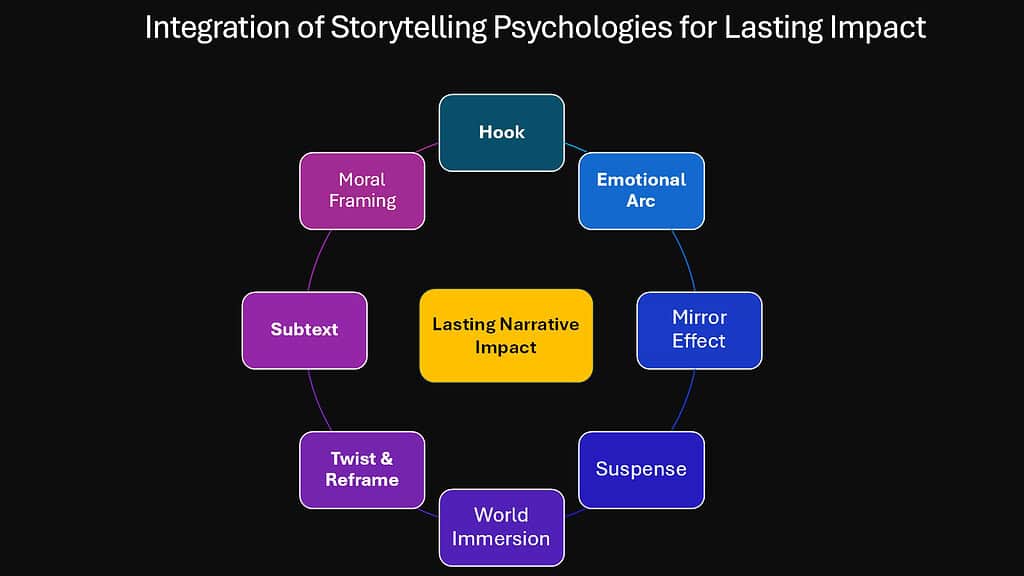
The eight storytelling psychologies explored throughout this analysis form an interconnected system for understanding and implementing sophisticated narrative craft. Each psychology contributes unique psychological mechanisms while reinforcing and amplifying the effects of others. When skillfully woven together, these approaches create stories that operate simultaneously on multiple levels of human consciousness.
Mastery of storytelling psychologies transforms writing from intuitive expression into precise psychological engineering. Writers gain the ability to predict and shape reader responses with remarkable accuracy, creating experiences that feel both surprising and inevitable. This mastery doesn’t diminish creativity; instead, it provides sophisticated tools for expressing creative vision with maximum impact.
The enduring power of these psychological principles lies in their foundation upon fundamental aspects of human cognition and emotion. While storytelling mediums and cultural contexts continue evolving, the underlying psychological patterns remain remarkably consistent. Stories that successfully employ these psychologies create lasting impressions that transcend temporal and cultural boundaries.
Future storytelling will likely integrate these traditional psychological approaches with emerging understanding of digital cognition, attention psychology, and interactive narrative structures. However, the core human needs for meaning, connection, and transformation that these psychologies address will continue driving effective storytelling regardless of technological advancement.
Table 10: Integrated Framework for Storytelling Psychologies
| Psychology Integration | Combined Effect | Reader Experience | Craft Application |
|---|---|---|---|
| Structure + Emotion | Predictable satisfaction | “This feels complete” | Balanced narrative architecture |
| Character + Theme | Meaningful identification | “This matters to me” | Purposeful character development |
| Suspense + Resolution | Satisfying conclusion | “That was worth the journey” | Strategic tension management |
| Surface + Subtext | Rich interpretation | “There’s more here to discover” | Layered meaning construction |
| Individual + Universal | Personal relevance | “This speaks to my experience” | Archetypal specificity |
The journey from novice storyteller to master craftsperson involves gradually internalizing these psychological principles until they become second nature. Like musicians who learn scales before creating symphonies, writers who understand storytelling psychologies gain the technical foundation necessary for creating works that resonate across time and culture, leaving indelible marks on readers’ hearts and minds.

